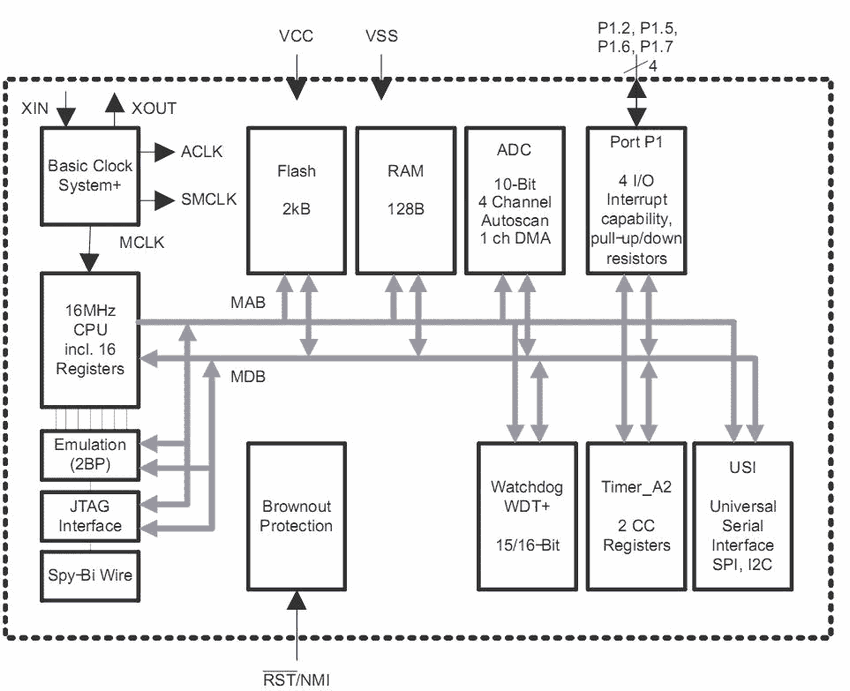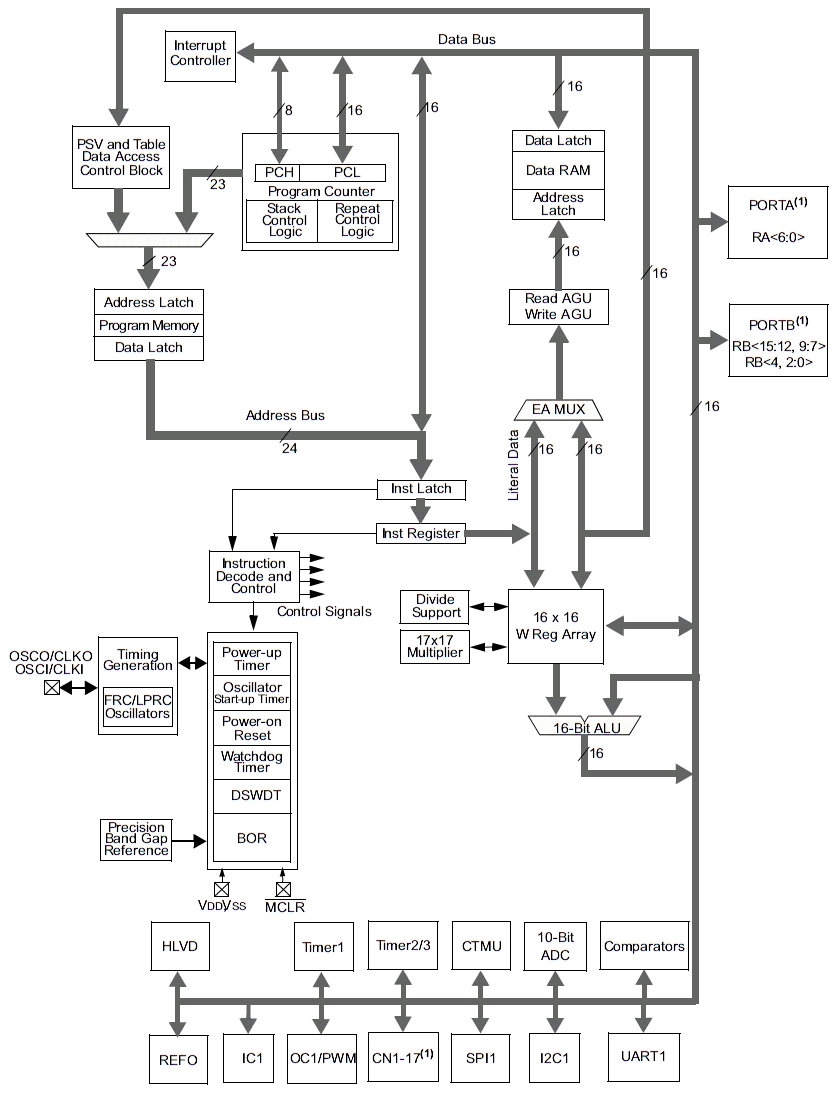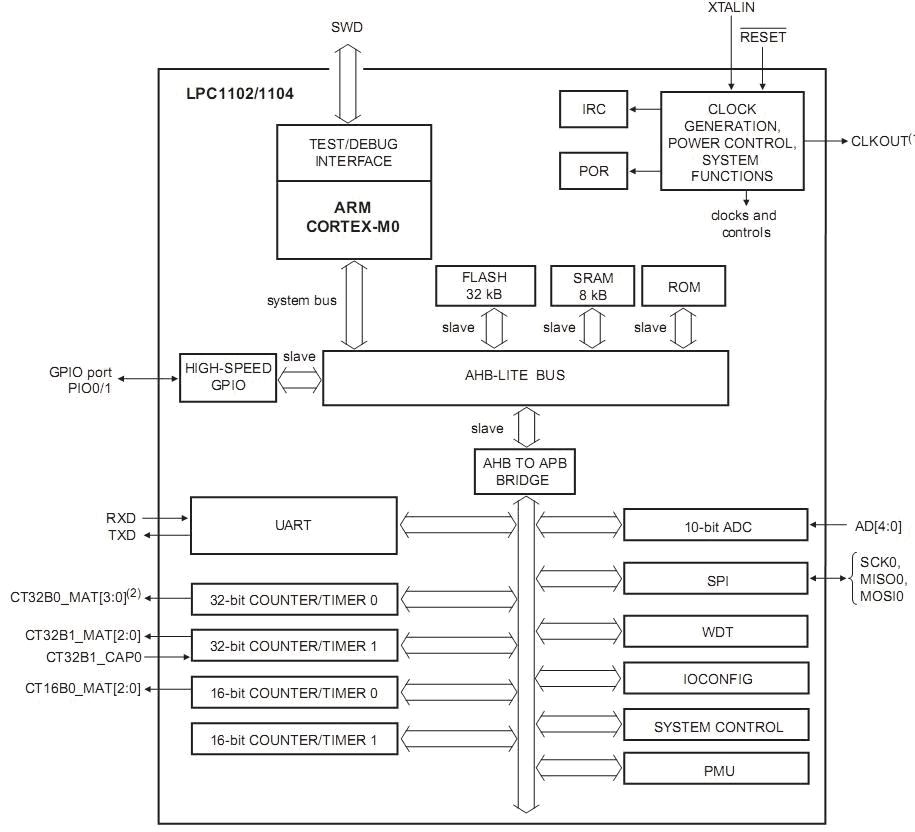16-bit
The internal 8-bit architectures work well, but if mixed-signal resolutions exceed 8 bits, a 16-bit core may be a good approach. Take for example the Texas Instruments MSP430G2230IDR 16-bit mixed-signal controller packaged in an 8-pin SOIC (Figure 3).
| Figure 3. | With a full 16-bit internal architecture, the MSP430 more easily handles higher-resolution analog signals. Multifunction pins backed by an analog multiplexer provide more analog flexibility. |
This is a fairly high-end 1.8 to 3.6 V processor in a very small package. On chip is 2 K of flash and 128 bytes of RAM. On chip compare functions or 10-bit slope-based A/D converters are available on some parts and these parts also have I²C, SPI, and a USI (Universal Serial Interface) ports. What’s more, this is part of a larger family of processors (MSP430) with scaled up pin counts, peripherals, and resources.
A key feature of the TI parts is that they take direct aim at low power applications. Only consuming 220 µA at 1 MHz) while active, these parts draw only 500 nA in standby mode. The 16-bit, 62.5 ns cycle times of the mostly single-cycle RISC instructions allows it to process quickly, then go back to sleep.
Another key benefit with the TI parts is the extensive training and development system support from TI. A dedicated ultra-low power MSP430 training module, and MSP430 Overview Training are a couple of examples. A dedicated training module is also online just to discuss development tool options for the MSP430. In any case, these widely used and very popular parts are well supported.
A larger 16-bit part that also targets low power designs comes from Microchip with its 14-pin 32 MHz (max) TSSOP PIC24F04KA200-I/ST. While almost twice as large as the 6- and 8-pin parts physically, this part contains nine 10-bit A/D converters, which can eliminate the need for external analog multiplexers when support for many analog signals is needed. It also contains more flash (4 Kbytes) and 512 bytes of SRAM (Figure 4).
| Figure 4. | Still small, this 14-pin micro with a 16-bit architecture takes advantage of the extra area to add more peripherals and functionality like hardware multiply and divide. |
A nice feature of the 1.8 to 3.6 V Microchip parts is the inclusion of fast 17 x 17-bit hardware multiplier and 32 x 16-bit divide instructions. This opens the door for rudimentary DSP functionality in a small-sized dedicated function processor.
These parts also contain I²C, SPI, and UART ports for communications eliminating the need for bit-banged firmware if communications is needed. Several low-power modes like doze, idle, sleep, and deep sleep keep the processors alive down to 20 nA, and there is a training module devoted to understanding the Microchip XLP deep sleep mode.
Small 32-bit parts
There are cases when 16 bits is not enough. Here is where 32-bit parts shine. Case in point is the NXP LPC1102UK,118 32-bit ARM core in a ball-grid-style 16-pin WLCSP package (2.17 × 2.32 × 0.6 mm). As part of the NXP LPC family or ARM Cortex-M0 processors, this 50 MHz 1.8 to 3.6 V part features a full internal 32-bit architecture with 32 Kbytes of flash and 8 Kbytes of SRAM (Figure 5).
| Figure 5. | A full 32-bit ARM Cortex M0 microcontroller with 32 K of flash is housed in a very small 16-pin BGA package. |
This part is packed with features. The 11 GPIO can be set as edge- or level-sensitive interrupts with or without pull-ups and open drain configurations. A clock out line is also a useful feature. A 10-bit A/D is fed by five multiplexed pins for mixed-signal designs.
The on chip boot loader supports in system programming and a serial wire debugger port allows examining registers and watch-points without burning up a lot of I/O. Because it implements the more compact ARM Thumb TDMI instruction set, achievable code densities allow these parts to handle software- or algorithm-intensive applications. There is also a training module from NXP highlighting code density features for the LPC family.
Conclusions
There are MCU design requirements where bigger is not necessarily better; in these cases, engineers have to turn to smaller processors that can still meet functionality obligations. Fortunately, as we have seen, there are low-pin-count 8-, 16-, and 32-bit solutions available, offering a variety of processing capabilities and accompanying resources. All parts, datasheets, tutorials, evaluation kits, and development kits referenced in this article can be found online at Digi-Key’s website. Use the links provided to access these product pages.


